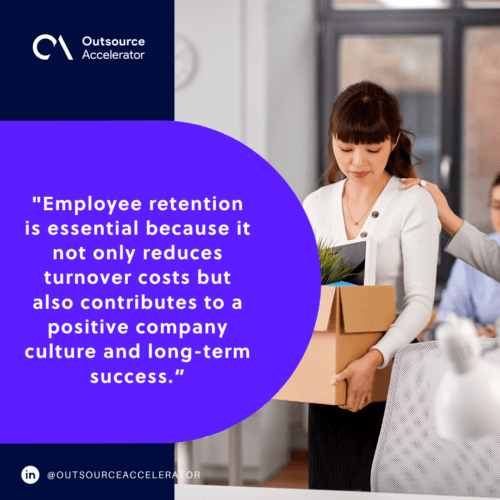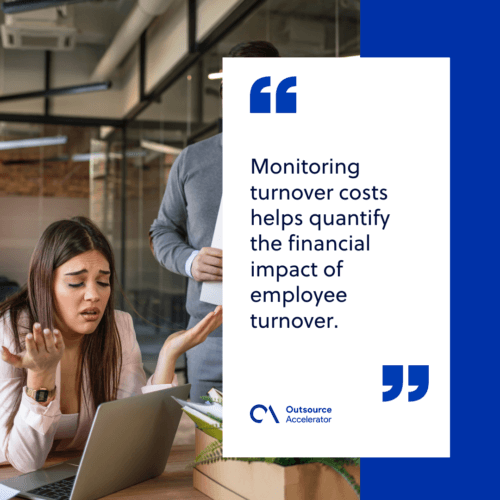10 employee retention metrics you need to track

Employee retention metrics to track
- Turnover rate
- Voluntary turnover
- Involuntary turnover
- Employee retention rate
- Turnover costs
- Absence rate
- Average employee length
- Retention per manager
- New employee satisfaction
- Overall employee satisfaction
Retaining quality employees is as crucial as hiring them. Your long-term employees are proof that you take care of your staff like you take care of your customers.
Employee turnover can be costly and disruptive. While some industries naturally have high turnover rates, constant hiring and turnover might lead to massive losses due to lost productivity and labor costs.
Fortunately, you can easily prevent these losses and improve your culture by monitoring employee retention.
By tracking the right employee retention metrics, you can gain valuable insights into your employees’ satisfaction.
In this article, we will explore the ten key employee retention metrics you should be tracking to ensure a stable and engaged workforce.
What is employee retention?
Employee retention is an organization’s ability to keep its employees long-term.
It measures how well the company creates an environment that motivates and engages employees. These factors may lead staff to stay and grow within the organization or look for another opportunity somewhere.
Employee retention is essential because it not only reduces turnover costs but also contributes to a positive company culture and long-term success.

Employee retention metrics
Employee retention metrics are measurable indicators that help organizations assess and track the factors influencing employee retention.
By tracking these metrics, companies can identify patterns, trends, and potential issues that may impact employee satisfaction.
This allows management teams to take proactive measures to improve retention and create a more productive work environment.
10 employee retention metrics to track
Tracking the following employee retention metrics will provide valuable insights into your organization’s retention efforts:
1. Turnover rate
The turnover rate is a crucial metric that measures the percentage of employees who leave your company within a specific period.
Companies usually calculate their turnover rates annually, and HR teams include them in their annual reports. The following formula calculates this.
Overall turnover rate = [(number of employee turnovers/average number of employees in a year)*100]
By tracking this metric, you can identify trends and patterns in employee attrition. Measuring this rate also allows you to delve deeper into the reasons behind it and take appropriate action to reduce turnover.
Employers can also classify and calculate turnovers into two categories: voluntary and involuntary turnovers.
2. Voluntary turnover
Voluntary turnover pertains to employees who opt to depart from the organization of their own accord.
Tracking this metric helps you understand why employees are opting to leave and whether some common themes or issues need to be addressed.
This includes career growth opportunities, work-life balance, or dissatisfaction with company culture. However, not all voluntary turnovers are bad.
In addition to the voluntary turnover itself, you can divide your results according to:
- Functional turnovers – These involve poor performers who leave your organization. Disengaged or unmotivated employees who wear your productivity down can help you save significant costs in the long run.
- Dysfunctional turnovers – Meanwhile, dysfunctional turnovers deal with top performers leaving your company. This is an aspect you should watch out for, as it can affect your culture and work environment.
3. Involuntary turnover
Involuntary turnover represents employees who are terminated or laid off by the organization.
This metric can provide insights into performance management, the effectiveness of company policies and practices, and the overall health of the business.
4. Employee retention rate
The employee retention rate measures the percentage of employees who remain with the organization over a certain period.
A high retention rate indicates a healthy work environment and positive employee experiences. On the other hand, low retention should prompt you to investigate what went wrong with employee experience.
Tracking this metric helps you gauge the overall success of your retention strategies.
5. Turnover costs
Monitoring turnover costs helps quantify the financial impact of employee turnover. This metric includes costs associated with recruiting, hiring, training, and lost productivity due to vacant positions.
Turnover cost is calculated with the following formula:
Overall turnover cost = total number of employees * turnover rate * cost of departure
Depending on the role, the average turnover cost of staff can reach up to twice their annual salary. High turnover rates and costs can result in firms losing more than they invest in a single employee.
By understanding the financial impact, you can build a compelling case for investing in employee retention strategies. This ultimately saves the organization money in the long run.

6. Absence rate
The absence rate measures the frequency and duration of employee absences.
According to the US Bureau of Labor Statistics, the average absence rate for employees across the country is 3.2%. High levels of absenteeism may indicate low employee motivation, engagement, or dissatisfaction.
By tracking this metric, you can identify potential employee retention issues and take corrective action to improve employee satisfaction and well-being.
Cultivating work-life balance within operations, for instance, can prevent high absence rates.
7. Average employee length
The average employee length measures the average tenure of employees within the organization. This metric can help you identify whether employees tend to stay for extended periods or leave relatively quickly.
It provides insights into the effectiveness of your onboarding process and employee retention strategies.
8. Retention per manager
Your management team can also affect employee retention. This is because they monitor and manage your teams on your behalf most of the time.
Examining retention rates per manager or supervisor can reveal which managers are most successful in retaining their team members.
This metric allows you to identify effective managerial practices and provide additional support to those who may need improvement.
By doing so, you can ensure that all managers are equipped to create an environment that encourages employee retention.
9. New employee satisfaction
Tracking the satisfaction of new employees provides insights into your onboarding and orientation processes.
Addressing any issues or gaps in the onboarding process can greatly impact new employees’ commitment to the company.
10. Overall employee satisfaction
Lastly, overall employee satisfaction is a critical metric to gauge the general sentiment and engagement within the organization. It captures the collective well-being and happiness of employees, indicating the overall health of the company culture and work environment.
A 2020 poll by Gallup states that engaged and satisfied employees can increase productivity and profitability by 18% and 23%.
Tracking this metric allows you to identify any concerns or areas for improvement that may be affecting employee retention.
Factors that affect employee retention
Employee retention may now always be a downright or straightforward thing to look into. Various factors can affect this matter, whether within or outside the business.
By addressing these factors, organizations can create an environment that fosters loyalty and long-term commitment.
The following factors play a significant role in employee retention:
Employee compensation
Employees’ skills and contributions should be matched with proper compensation as a thank you for their hard work. Regularly adjusting compensation to align with market standards can significantly impact employee retention.
Professional development opportunities
Employees who see a clear career path and have access to ongoing learning and development programs are more likely to stay with an organization.
Investing in their professional development not only improves their skills. It also shows that you value their growth and advancement.
Support from managers
Managers play a critical role in employee retention.
Employees who feel supported by their managers, receive regular feedback, and have open lines of communication are more likely to stay.
Managers should be trained in effective communication and leadership skills to create a positive work environment that fosters loyalty and engagement.
Work environment
A positive work environment with a healthy company culture is essential for employee satisfaction and retention.
Employees thrive in environments where they feel valued and respected and have a sense of belonging. This is usually tied up to your work culture and company vision.
Creating a supportive and inclusive work environment promotes employee engagement and reduces turnover.
Work-life balance
Maintaining a healthy work-life balance is becoming increasingly important in today’s fast-paced world. Organizations that prioritize work-life balance demonstrate their commitment to their employees’ well-being.
Flexible work arrangements, time-off policies, and supportive initiatives help employees manage their personal and professional lives.
Why you should track employee retention metrics
Tracking employee retention metrics has numerous benefits for organizations. It allows you to:
- Identify potential retention issues and proactively address them before they escalate.
- Understand the effectiveness of your current employee retention strategies and make data-driven adjustments to improve outcomes.
- Benchmark your organization’s retention performance against industry standards to see how you stack up.
- Quantify the financial impact of turnover and make a compelling business case for investing in employee retention initiatives.
- Foster a culture of continuous improvement by monitoring and measuring the success of your retention efforts, ensuring it remains a priority.
Employee retention metrics are crucial for organizations aiming to retain their top talent, reduce turnover costs, and create a supportive work environment.
Companies can ensure the long-term success and growth of their workforce by tracking these metrics and addressing the factors that influence retention.
It’s best to start monitoring these metrics today and secure the future of your organization.








 Independent
Independent




